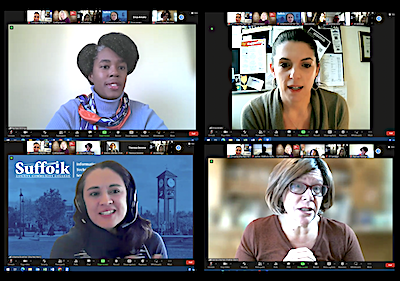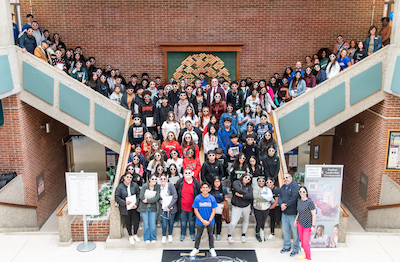| |
 |
| |
Four of our five presenters at the January JEDI workshop are shown above, clockwise from top left: Rachael Millings, Erica Amato, Danna Prather Davis and Johanna Boutcher. |
| |
|
In the past few months, I’ve heard it over and over again. It comes in different forms, but every one is a clear expression of the college’s newly revised mission statement: “SUNY Suffolk is a student-centered college community serving Suffolk County and beyond by providing open access to exceptional educational opportunities.”
Being involved in so many different committees and roles at the college through both governance and union roles, every week I am impressed with the good work of my colleagues and their dedication to making SCCC truly a more student-centered college community.
Below I share some highlights of faculty work in the JEDI Institute, the college’s new Equity and Inclusion Council and the Distance Education Committee.
State of the JEDI
On Friday, January 5, we hosted our annual winter meeting for our 2023-24 JEDI Institute participants. I summarize the projects of the colleagues who presented for us to highlight the range and type of activities developed by JEDI faculty and staff. Each one demonstrates a commitment to making our college community more student centered, diverse and inclusive.
- Danna Prather Davis (Communication, Ammerman) spoke about having taken the SUNY CPD certification courses on equity, inclusion and diversity as part of her JEDI work. “These are well worth investigating,” Danna notes. “Faculty new to DEISJ are likely to find the initial class an invitational way to learn more in a non-threatening environment. Should FA members choose to do a three-course microcredential, I suspect most would find their second and third class particularly useful, with new information for both teaching and nonteaching faculty” as well as specific, actionable materials for classes. Danna is also experimenting with honors students to co-create some assignments and rubrics for use in class.
- Rachael Millings (Mathematics, Eastern) began her presentation by noting it is our obligation to help all students succeed. As a woman of color and an SCCC graduate, she explained, it was challenging to reflect on discrepancies she had noticed among her student outcomes, especially based on race and gender. She indicated she has been thinking deeply about what she might have been complicit in. “The questions I am working on now,” Rachael shared with the group, “include how can I make it inevitable that students will engage in my teaching strategies and how can I normalize struggle, learning from failure and perseverance?” As a statistician, Rachael is digging into disaggregated class-level data to help revise her teaching strategies. (More on Rachael’s good work can be seen in this American Federation of Teachers article.)
- Johanna Boutcher (College Assistant Director, IT Operations) co-authored with Christina Johnston-Eustace an article in our last issue of The WORD about removing technology barriers as a JEDI strategy. Johanna is well aware of how technology infuses all we do in higher ed and the broad range of student access to and comfort with technology. Her JEDI work matters profoundly, as it crosses all disciplines and departments. She is eager to help faculty become more aware of how to notify students of all the tools and support the college offers if they don’t have access at home, especially the newer and simpler help number: 631-451-HELP or 631-451-4357 (students press 2 for help, faculty with classroom questions press 1, and faculty & staff outside the classroom press 3). In addition, Johanna makes sure technology staff have annual trainings on diversity, they use diverse representations in their media, and the staff members themselves are diverse. Next up, she added, is a project to provide technology guides in Spanish.
-
| |
 |
| |
Erica Amato and Jared Dowd, co-chairs of the FA Take a Look at Teaching initiative, stand in the center of the dozens of local high school students who came to campus last November to tour campus and learn about pursuing education as a career. (photo by Victoria Pendzick) |
| |
|
Erica Amato and Jared Dowd (both in Counseling, Grant) lead the FA’s Take a Look at Teaching project, for which we have received a grant from New York State United Teachers. This union-led initiative aims to increase the number of students entering careers in teaching, improve diversity in the education workforce, elevate the teaching profession and expand community partnerships to enhance teacher recruitment and to support early career educators. Enrollment in teacher education programs in New York has declined by 50.4% since 2009 and projections anticipate a need of up to 180,000 teachers in the next decade. Erica and Jared’s good work has brought hundreds of local high school students to campus, from a range of diverse backgrounds. This is good news, since racially minoritized students make up 56% of total enrollment in the state but only 19% of teachers are members of racially minoritized groups. They are working hard to help change those statistics.
- Aimee Mattiolo (Dietetics Technology, Eastern) is focused on a unique JEDI project about consideration and inclusion of foods from all cultures. Aimee has introduced new activities in her nutrition classes to examine assumptions regarding what is common, normal and healthy to eat. Students share a variety of foods that are common in their home, community or ethnicity. “Students introduced the group to dishes such as cuy (fried guinea pig), blood pudding (made of pork fat, pork blood and oatmeal), Manish water (made from goat head and intestines), pig knuckles, chicken feet and tacos de lengua (made from cow tongue).” The goal is to expose students to foods from diverse cultural groups and encourage food acceptance rather than food shaming. “Students are learning not to make assumptions,” Aimee added. A common example is how nutrition students are quick to advocate for cooking with brown rice because it is healthier, but with sizable Hispanic and other ethnic communities on Long Island, Aimee explains that many people simply will never substitute that for white rice, so students have to take into account different cultural perspectives.
While very different in content and purpose, each of the above JEDI projects shows how our faculty are doing the work that will help more students succeed. And this is just a sample of five from our 2023-24 cohort! Join the JEDI Institute this summer, so you can have the space, time and collegial support to develop your own projects. Contact Christina Vargas to sign up.
Not a fight for one but a fight for all
At a recent meeting, I was sitting with Kaliah Greene, executive director of OPIE, when she shared something with our group that really struck me. “When it comes to anything relating to diversity, equity and inclusion,” Kaliah said, “people forget that it is not a fight for one but a fight for all.” She continued, “It’s the student with learning disabilities. It’s the military-connected and veteran student. Diversity, equity and inclusion includes everyone.” That is, sometimes people see a reference to DEI, imagine it is really only about race—and in particular about Black, African American or Caribbean people—and get stuck right there. They cannot get beyond that to understand that it is truly about fighting for all.
This resonated with me because as I had listened to the JEDI presentations above just three weeks earlier, I recognized how each colleague’s JEDI project would make all students’ experiences better as a result. As I noted in my December JEDI article, DEI is not some secret liberal code for focusing on what divides and separates us. It’s about addition, not division. It’s a fight for all. We want all students to succeed.
This is why the college has established an Equity and Inclusion Council (EIC) to provide recommendations for policies and practices that will advance equitable student access and success. The EIC is charged with promoting systems of support for students from various identities, supporting the objectives outlined in the college’s strategic plan and facilitating strategic and collaborative partnerships to meet the needs of students and that foster educational opportunities and student success.
Having begun conversations during fall 2023, we have now established the following subcommittees to shape our work in spring 2024.
- College Culture and Professional Development: Co-chairs Carol Hernandez and Cynthia Eaton
- Search, Selection, and Retention: Co-chairs Dionne Walker-Belgrave and Naomi Edwards
- Student Success: Co-chairs Shannon O'Neill and Tom Flesher
The work of each group, as Kaliah so aptly phrased it, is to think strategically about how we can better fight for all students as we work to move the institution forward.
Distance Education Committee
Finally, the work of the college distance education committee continues to shift as our faculty continues to grow and change.
We currently have over 475 faculty who are permanently certified in fully asynchronous and blended courses and about 250 courses that have been approved for fully asynchronous or blended delivery. Currently, though, the ratio of on-campus classes to DE modality classes is approximately 70% on campus, which we believe is best for students at this time.
Given the re-envisioning of what used to be called Center for Innovative Pedagogy as the current Center for Teaching and Learning—and with a new dean overseeing the area—we are working hard on professional development. One project in the hopper would be a learning objects repository that can reside in Brightspace for faculty to access and download any pages, modules, files, quizzes or other materials that they would like to use in their own classes.
Stay tuned for more on that, as we will be reaching out to the college community for ideas. We know that plenty of great pedagogical strategies are thriving in classrooms across the college, both on campus and in various distance education modalities. We would love to hear them! |

